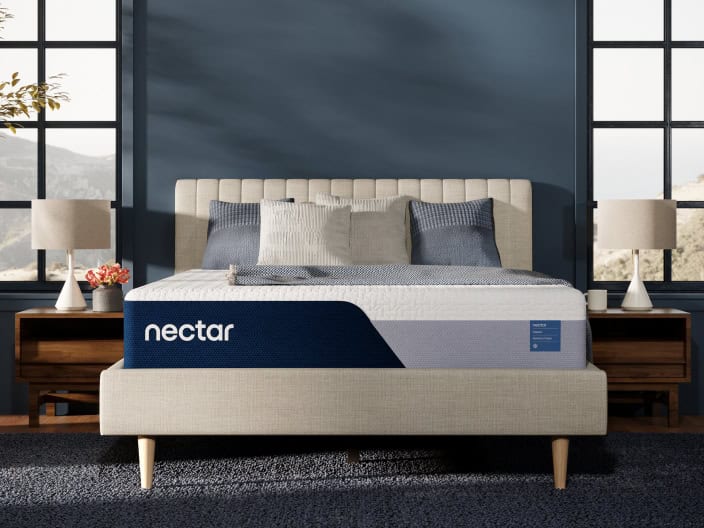10 Signs You Need A New Mattress
Share
Fact checked
Reviewed by experts
Updated
December 15, 2022
Quick read
5 mins to read
List of Content
While a typical individual spends a third of their lives in bed, those lengthy hours aren’t necessarily as relaxing as they should be. According to the Centers for Disease Control and Prevention (CDC), one 1 of every 3 individuals in the United States isn’t getting enough sleep, and a terrible mattress might be to blame for some of them. If you’re in the dilemma about getting a new mattress, keep reading to learn the signs you need a new mattress.
When you’re having trouble sleeping, your bed might not be the only thing that comes to mind. However, your body may detect the need for a mattress replacement even before your eyes do. Mattresses decompose or need to be changed for a variety of reasons. Here are such 10 signs for you to observe and take actions upon for a new mattress.
Signs You Need a New Mattress
1. Soreness Upon Waking up
You definitely need a new mattress if you wake up each day with fresh aches and pains. Neck, shoulder, lower back, and hip discomfort can all be caused by an outdated mattress. This occurs when your mattress no longer provides the support you require.
In your bed, you may also detect the actual shape of body imprints. The goal of supportive beds is for them to return to their original state. When your mattress sheds its form, it can no longer accommodate the natural curve of your spine. As a result, various portions of your body are stressed while you sleep. One of the early signs you need a new mattress.
2. Visible signs of damage
It’s better to replace your current mattress with a new mattress when it starts to show indications of wear and tear. These signs can be shown in the following ways:
- Sagging
- Tears that are visible
- Ripping
- Holes
- Stains
- Other types of harm
3. Your Asthma or Allergies Have Become Worse
It might be your mattress if your allergies have become worse despite the fact that allergy season has passed. Dust mite feces can irritate the lungs, triggering allergies and asthma. Dust mites might be more prevalent in older mattresses than you might imagine.
Despite the fact that older mattresses have the largest concentration of dust mites of any item in your home, your old mattress might hold something more than dust mites.
4. It’s more than eight years old
The lifetime of various mattresses varies. The longest lasting bed is a waterbed, which may endure anything between 12 to 15 years. A foam bed, whether latex or gel, typically lasts 10 to 15 years. If rotated properly, a memory foam bed may last 8 to 10 years. An innerspring mattress, on the other hand, can last up to 8 years. The longevity of a mattress is determined by how well it is cared for and maintained.
It’s critical to invest in a decent and new mattress since its quality will determine how long it lasts and how healthy it is for your body. In most cases, you should upgrade your mattresses after 6 to 8 years. You can check out our mattress guide here to learn more about mattresses before investing into a new one..
5. You’re Warming Up
Your mattress may need to be replaced if you consistently become overheated in bed or wake up sweaty. It’s a solid indicator that your mattress is starting to break down if you didn’t have an issue with temperature control when you originally got it. The fabrics will soften and limit circulation on the surface the longer you keep the mattress.
If you maintain your room extremely hot or chilly, your mattress can wear out sooner. This type of exposure can cause the material to degrade, and it is particularly frequent in persons who use all-foam mattresses.
6. Sleeping Problems
The next symptom that your mattress is in need of replacement is difficulty sleeping. Even if you aren’t aware of discomfort — or have just tolerated it — your mattress might be the source of your sleeping problems. One method is to spend one night on a different bed. It’s a good idea to start shopping for a new mattress if you’re sleeping considerably better.
Not sleep deprivation may lead to a lot of stress and sleep difficulties.
7. Your Mattress Is Sinking
When you’re switching your sheets and cleaning your mattress cover, take a close look at your mattress. Does it appear to be even all the way around? Mattresses can droop in some areas over time, particularly if you sleep in the same spot on the bed every night. Even just an inch or two of sagging can cause serious damage to your spine and prevent you from getting a good night’s sleep.
Rotating your mattress is one strategy to avoid a drooping mattress, especially if you lay on one edge of the bed if you are not getting a new mattress anytime soon.
8. Your mattress is making a lot of noise
Is your mattress becoming to resemble your pet’s favorite toy? Squeaking indicates that your mattress’s springs are beginning to break down, making it less supportive, pleasant, and, well, springy.
Check your box spring or bed base first before blaming the noise on your mattress. These are also subject to deterioration.
9. You’re in pain
You retire to your bed to unwind your body and mind. Not to obtain new ones, but to relieve aches and pains that have built up over the day. You shouldn’t be waking up gripping your back or experiencing unanticipated pain in your body unless you’re doing hard exercise on a regular basis or have a profession that requires a lot of the heavy lifting.
This might indicate that your mattress is no longer fully supporting you. However, looking at the composition of your mattress might be beneficial:
- If you sleep on a memory foam mattress, this might not return to its normal shape and no longer adheres to your body shape as it should.
- Check for lumps, bumps, and “hammocking,” when you feel like you roll to the center of your mattress when you lay down, if you have a different mattress form like latex, hybrid, or innerspring.
10. Sleeping arrangements for two
Being pregnant is one of the more thrilling reasons to acquire a new mattress. Because your body changes more during and then after pregnancy, a customized mattress and adaptable bed is an excellent choice for providing support at each step of the trip.
During pregnancy, custom side-sleeping support may assist your tummy and avoid back strain, and it can be simply switched back to your preferred sleep position thereafter. Plus, while you’re pregnant, an adaptable bed makes it simpler to get out of bed. It also helps preserve stomach muscles after a C-section and makes breastfeeding more pleasant.
11. The Goldilocks effect
Owners of memory foam mattresses should be aware if their mattress gets excessively firm or soft. Because memory foam is temperature sensitive (which is why many people “sleep hot” on memory foam mattresses), it will harden over time if stored in a confined room, and soften with time if maintained in a warm atmosphere. This shift in hardness can have a significant impact on your comfort.
Conclusion
It should be simple to determine when a mattress needs to be changed. Keep a close eye out for things like sagging, noise, and pain, and if you’re not sure, try sleeping on a new mattress for the next few nights to see how you feel.
Plan on taking steps to get the most years out of your mattress before replacing it and after you’ve purchased a new mattress.
FAQs
With careful maintenance, certain mattresses may survive up to 20 years, but this is unusual. High-quality mattresses constructed of organic memory or latex foam are recommended.
Whenever your memory foam mattress is sinking in the middle, a temporary fix is to place some hard cardboard or plywood underneath it. If the base is insufficient, lay the mattress on the floor. A mattress topper might also make your sinking mattress feel more comfortable.
Mattresses made of memory foam and latex should be changed 1-2 times each year. Innerspring mattresses that are less than a year old must be rotated 1-2 times each year. 2–5 times each year, older innerspring mattresses should be turned.
This website does not offer medical advice nor professional medical services; rather, it is provided solely for educational, informational, and/or entertainment purposes. Individuals seeking medical advice should consult a licensed physician. The information provided should not be used for diagnosis or treatment of any condition, disease, or injury. When you have a medical condition, you should always talk to licensed doctor or other certified medical professional. You should never delay seeking professional medical advice or treatment based on the contents of this website. Call 911 or immediately go to the nearest emergency room if you think you may have a medical emergency. The contents of this website are provided “as-is”, Sleep Authority and its parent, subsidiaries, affiliates, employees, contributors disclaim any warranty of the information contained herein. Please contact using contact form to report any errors, omissions, misinformation, or abuse.
Sleep Authority is brought to you by Resident, the company that brings you Nectar, DreamCloud, Awara, Wovenly, Bundle, Home Well Designed and Level Sleep.




